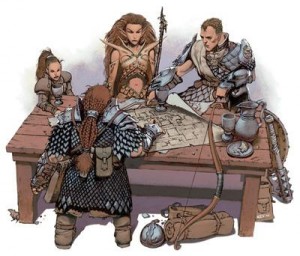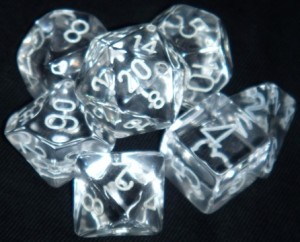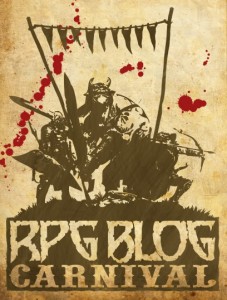February is DM appreciation month. It’s a chance for players to recognize the DMs who make the game happen and say thank you. Even though I generally DM during public play and at my home games, I’ve had the privilege and good fortune to play under some phenomenal DMs in my years of play. Throughout this month I’m going to write a series of blog post about some of the very best DMs I’ve ever had. It’s my way to give back to the gaming community and give proper praise where it’s due. I always try to say thank you to the DM at the end of a good session, but sometimes that’s not enough. DM appreciation month is my opportunity to go one step beyond a simple, heart-felled thank you.
Tag: Dungeon Master Resource
On Friday we comb through our extensive archives to find an older article that we feel deserves another look. From January 7, 2011, Dungeon’s Master once again presents: How To Handle A Split Party In 5 Easy Steps.
It happens in every campaign, one player decides to go off and pursue an agenda or lead that only they understand. The player is totally focused on their objective, nothing else seems to matter. No one else at the table understands it. The DM is at his wits end to contain and control the situation. The other players are slowing losing interest and the entire adventure is about to be waylaid.
If you’ve ever sat at a table where you weren’t the player things were focused on, you know the boredom that soon sets in. The frustration at wanting to move forward, but not being able to due to the indulgence or poor planning of the DM. If you haven’t lived through this eventuality you likely haven’t been playing D&D very long, but don’t worry I’m sure it will happen to you soon enough.
In order to make this eventuality less painful for everyone, here are five steps that provide some straightforward advice on how to handle things if one or more players decide to split the party.
While the Dungeon’s Master team enjoys some well-deserved vacation time, we’re breaking out the greatest hits and shining a spotlight on a few of our favourite articles from 2012. We’ve searched for hidden gems that our newer readers might have missed and our long-time readers will enjoy reading again. Enjoy a second look at these greatest hits from Dungeon’s Master.
Two heads are better than one. Yet in D&D the DM almost always flies solo. It’s rare that the DM will ask any of the players for help, especially when it comes to designing encounters. After all, the DM doesn’t want one player knowing where the traps are or what kind of monsters that will attack the party around the next corner. So most DMs go it alone.
This can lead to problems when you have one DM doing all the work for extended periods of time. Most DMs have a certain style. They might use or avoid using some monsters. They might throw in lots of minions. They might overuse traps. The point is that the group may be bored or even sick of having the same DM give them the same things over and over again. My group rotates the DM to help avoid these problems but I know this is not the case for all groups. If you’re stuck with the same DM and you’re not wild about his DMing style what can you do? Insist the DM get help from the rest of the group.
In most groups each participant brings a different specialty to the table. For example in my group we have one player who loves to create new monsters. We’ve learned to draw on this skill when we need something unique (usually a big boss monster). Sure that player will know the monster’s vulnerability or lowest defense, but he’s good at not letting that affect his play. Another player is great at designing traps, so again the DMs will tap him for help to really make the next dungeon deadly.
The point is that DMs shouldn’t feel that they need to do all the heavy lifting by themselves. You’ve got a table full of gaming geeks that are all creative. Let them add their 2 cents to the design of an encounter. You don’t have to use what they provide exactly as they’ve provided it, but you should be open to the wealth of knowledge your gaming group can offer even when they’re just the players.
September 25, 2012, Dungeon’s Master once again presents: Collaborative Dungeon Design.
Collaborative Dungeon Design
 It’s unusual for DMs to get the players to help them design encounters. After all, part of the fun of being a player is the element of the unknown. Players love it and DMs relish in it. The idea that the DM springs the unknown on the players is practically a mandate of D&D. I know this is how things usually work when I’m the DM. I have a vision of what an encounter will be like or where it will take place and I make it happen. I create the encounters in secret. The last thing I want is for the players to have any foreknowledge of what’s next. In fact I’ve gone so far as to change details if I discover they know something they shouldn’t about the next encounter.
It’s unusual for DMs to get the players to help them design encounters. After all, part of the fun of being a player is the element of the unknown. Players love it and DMs relish in it. The idea that the DM springs the unknown on the players is practically a mandate of D&D. I know this is how things usually work when I’m the DM. I have a vision of what an encounter will be like or where it will take place and I make it happen. I create the encounters in secret. The last thing I want is for the players to have any foreknowledge of what’s next. In fact I’ve gone so far as to change details if I discover they know something they shouldn’t about the next encounter.
During my recent introduction to the Dresden Files RPG I experienced the extreme satisfaction of being part of the collaborative city creation process. The game takes place in a city that everyone helps develop. The DM (or in this case GM) still has the final say, but all the players work together to make the setting interesting. Of course it didn’t take long to see how this exercise could be just as useful to other games, namely D&D.
 It will happen to you one day and when it does don’t be embarrassed, it happens to all gamers. I’m talking about cold dice. Eventually the dice run cold for all of us. Maybe the d6 keeps coming up 1, the d12 won’t roll higher than 3 or the d20 isn’t cooperating at all and you haven’t hit a monster all fight. Eventually the dice gods will correct the problems and balance the scales, but until then a streak of poor rolls can crush even the most experienced player.
It will happen to you one day and when it does don’t be embarrassed, it happens to all gamers. I’m talking about cold dice. Eventually the dice run cold for all of us. Maybe the d6 keeps coming up 1, the d12 won’t roll higher than 3 or the d20 isn’t cooperating at all and you haven’t hit a monster all fight. Eventually the dice gods will correct the problems and balance the scales, but until then a streak of poor rolls can crush even the most experienced player.
When a player goes through a bought of bad dice karma it can actually have a detrimental effect on the entire group. Even though everyone else rolls as expected and has fun doing so, one player’s poor rolls can effect the overall mood of the entire table. I’ve learned over the years that when this happens (and it will, if it hasn’t already) players and DMs can actually do a lot of things to turn the tide.
How many times has your party faced an encounter that was basically the heroes on one side, the monsters on the other side, and then the two forces bashing each other’s brains in until one side (usually team heroes) ends up destroying all of the opponents? I’d hazard a guess that most players see this kind of encounter most of the time. There’s nothing wrong with it, but if you play a lot of D&D this kind of setup gets really boring really fast.
Encounter design is one of those things that only gets better with practice. To help you get better at encounter design we’ve listed a few tips that we think all DMs will find useful. There are plenty of ways to make a regular encounter more interesting and more exciting. Little things that the DM can add or actions the DM can have the monsters take beyond just rushing the PC and try to kill them. Most of these tips will likely seem like common sense, but seeing them listed should remind DMs that using any or all of these tips can easily put an end to boring encounters once and for all.
Most players select a background for their PC during the character creation process. In many cases it’s done for purely mechanical benefits. Being from this location may give you a resistance to fire, while this one may give you a bonus to your initiative. In all cases it also gives you access to a new skill or a bonus to one specific skill. When it comes to power gaming, no one overlooks a background benefits.
The background options that I see taken most often are the geographic backgrounds from the Forgotten Realms. Usually the player doesn’t really care that his PC is from Waterdeep, Akanul or Cormyr, they just want to additional benefit that being from those places provides. And that’s fine. It’s not the ideal reason to choose a background but it’s well within the rules. Any character can have any background.
This season during D&D Encounters: Beyond the Crystal Cave the adventure strongly encourages the DM to insist that the PCs choose one of the three backgrounds provided. This helps give the players a good in-game reason as to why such a rag-tag and mismatched adventuring party would work together. Being from one of the three areas directly impacted by the happenings in the adventure gives PCs a strong motive for accepting the mission.
While at first a few of the players in my group resented being told they had to choose one of only three options (none of which they felt provided particularly appealing benefits) after only two sessions these same players really started working their background into the way the characters behaved. Without any prompting from me, the players instilled within their characters a sense of national pride.
The End Is The Beginning
One of the great things about role-playing games is that they are a shared story-telling experience. No matter what the DM might have plotted out as a story arc, as soon as the players get their characters into the action things are going to change. This is an expected part of the experience. The outcome is not set (although it’s a pretty good bet that the heroes will be victorious). But what if the players and DM set the end before the game ever begins?
Imagine that five players and a DM get together to begin a new level 1 campaign. Before anyone talks about character concepts or story ideas, the DM begins with the end. He gives a very high-level overview of how he sees that campaign ending at epic level. The players are then encouraged to help shape this final battle. They each get to talk about their character (the ones they’re about to create) and how they see these characters participating.
Before anyone even opens character builder or fills out a character sheet, this final epic battle is described in great detail. The heroes save the world and defeat the evil on the very first night. Now they’re ready to begin.
Incremental Encounters
A typical encounter has five PCs facing off against five equally powerful monsters and everything happens simultaneously. But what if the encounter was broken down into five incremental steps, each step representing one monster, and the outcome of each step determined the threat level of the step to follow?
Before diving into this scenario let’s not overlook skill challenges. What if, instead of automatically using five monsters, the DM used five complexity 1 skill challenges, or even a combination of five monsters and skill challenges? Assuming that monsters and skill challenges can be used interchangeably to create balanced and satisfying encounters, is this kind of incremental encounter viable? Absolutely.
June RPG Blog Carnival Round Up
 The June RPG Blog Carnival has concluded and the Dungeon’s Master team would like to thank all the participants. This month we asked you to create a memorable character inspired from real life. The participating posts were all very engaging and creative. While reading each of them I found myself thinking, now why didn’t I think of that?
The June RPG Blog Carnival has concluded and the Dungeon’s Master team would like to thank all the participants. This month we asked you to create a memorable character inspired from real life. The participating posts were all very engaging and creative. While reading each of them I found myself thinking, now why didn’t I think of that?
I hope you enjoyed this month’s carnival and the submissions that it brought. Be sure to read each submission and surprise your table with a character inspired from real life.